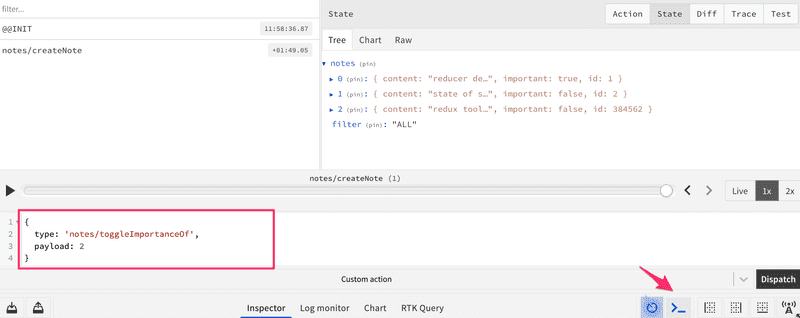b
Many reducers
Let's continue our work with the simplified Redux version of our notes application.
To ease our development, let's change our reducer so that the store gets initialized with a state that contains a couple of notes:
const initialState = [ { content: 'reducer defines how redux store works', important: true, id: 1, }, { content: 'state of store can contain any data', important: false, id: 2, },]
const noteReducer = (state = initialState, action) => { // ...
}
// ...
export default noteReducerStore with complex state
Let's implement filtering for the notes that are displayed to the user. The user interface for the filters will be implemented with radio buttons:

Let's start with a very simple and straightforward implementation:
import NoteForm from './components/NoteForm'
import Notes from './components/Notes'
const App = () => {
const filterSelected = (value) => { console.log(value) }
return (
<div>
<NoteForm />
<div> <input type="radio" name="filter" onChange={() => filterSelected('ALL')} /> all <input type="radio" name="filter" onChange={() => filterSelected('IMPORTANT')} /> important <input type="radio" name="filter" onChange={() => filterSelected('NONIMPORTANT')} /> nonimportant </div> <Notes />
</div>
)
}Since the name attribute of all the radio buttons is the same, they form a button group where only one option can be selected.
The buttons have a change handler that currently only prints the string associated with the clicked button to the console.
In the following section, we will implement filtering by storing both the notes as well as the value of the filter in the redux store. When we are finished, we would like the state of the store to look like this:
{
notes: [
{ content: 'reducer defines how redux store works', important: true, id: 1},
{ content: 'state of store can contain any data', important: false, id: 2}
],
filter: 'IMPORTANT'
}Only the array of notes was stored in the state of the previous implementation of our application. In the new implementation, the state object has two properties, notes that contains the array of notes and filter that contains a string indicating which notes should be displayed to the user.
Combined reducers
We could modify our current reducer to deal with the new shape of the state. However, a better solution in this situation is to define a new separate reducer for the state of the filter. Let's also create a new action creator function and place the code in the module src/reducers/filterReducer.js:
const filterReducer = (state = 'ALL', action) => {
switch (action.type) {
case 'SET_FILTER':
return action.payload
default:
return state
}
}
export const filterChange = filter => {
return {
type: 'SET_FILTER',
payload: filter
}
}
export default filterReducerThe actions for changing the state of the filter look like this:
{
type: 'SET_FILTER',
payload: 'IMPORTANT'
}We can create the actual reducer for our application by combining the two existing reducers with the combineReducers function.
Let's define the combined reducer in the main.jsx file. The updated content of the file is as follows:
import ReactDOM from 'react-dom/client'
import { Provider } from 'react-redux'
import { createStore, combineReducers } from 'redux'
import App from './App'
import filterReducer from './reducers/filterReducer'
import noteReducer from './reducers/noteReducer'
const reducer = combineReducers({
notes: noteReducer,
filter: filterReducer
})
const store = createStore(reducer)
console.log(store.getState())
ReactDOM.createRoot(document.getElementById('root')).render(
<Provider store={store}>
<div />
</Provider>
)Since our application breaks completely at this point, we render an empty div element instead of the App component.
Thanks to the console.log command, the state of the store is printed to the console:

As we can see from the output, the store has the exact shape we wanted it to!
Let's take a closer look at how the combined reducer is created:
const reducer = combineReducers({
notes: noteReducer,
filter: filterReducer,
})The state of the store defined by the reducer above is an object with two properties: notes and filter. The value of the notes property is defined by the noteReducer, which does not have to deal with the other properties of the state. Likewise, the filter property is managed by the filterReducer.
Before we make more changes to the code, let's take a look at how different actions change the state of the store defined by the combined reducer. Let's temporarily add the following lines to the file main.jsx:
// ...
const store = createStore(reducer)
console.log(store.getState())
import { createNote } from './reducers/noteReducer'import { filterChange } from './reducers/filterReducer'
store.subscribe(() => console.log(store.getState()))store.dispatch(filterChange('IMPORTANT'))store.dispatch(createNote('combineReducers forms one reducer from many simple reducers'))
ReactDOM.createRoot(document.getElementById('root')).render(
<Provider store={store}>
<div />
</Provider>
)By simulating the creation of a note and changing the state of the filter in this fashion, the state of the store gets logged to the console after every change that is made to the store:
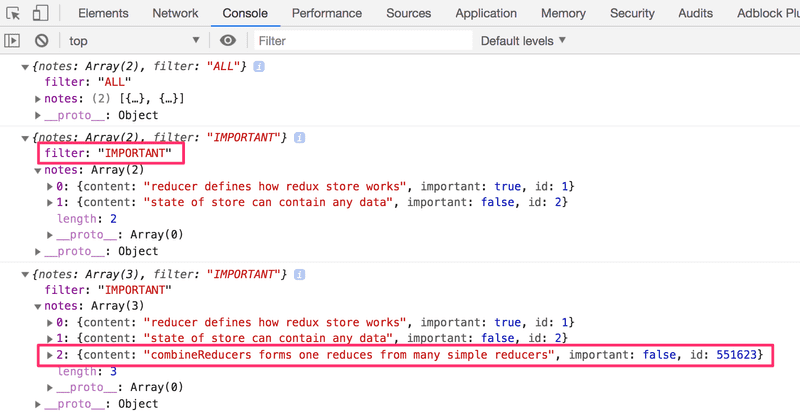
At this point, it is good to become aware of a tiny but important detail. If we add a console log statement to the beginning of both reducers:
const filterReducer = (state = 'ALL', action) => {
console.log('ACTION: ', action) // ...
}Based on the console output one might get the impression that every action gets duplicated:

Is there a bug in our code? No. The combined reducer works in such a way that every action gets handled in every part of the combined reducer, or in other words, every reducer "listens" to all of the dispatched actions and does something with them if it has been instructed to do so. Typically only one reducer is interested in any given action, but there are situations where multiple reducers change their respective parts of the state based on the same action.
Finishing the filters
Let's finish the application so that it uses the combined reducer. Let's remove the extra test code from the file main.jsx and restore App as the rendered component. The updated content of the file is as follows:
import ReactDOM from 'react-dom/client'
import { Provider } from 'react-redux'
import { createStore, combineReducers } from 'redux'
import App from './App'
import filterReducer from './reducers/filterReducer'
import noteReducer from './reducers/noteReducer'
const reducer = combineReducers({
notes: noteReducer,
filter: filterReducer
})
const store = createStore(reducer)
console.log(store.getState())
ReactDOM.createRoot(document.getElementById('root')).render(
<Provider store={store}>
<App />
</Provider>
)Next, let's fix a bug that is caused by the code expecting the application store to be an array of notes:

It's an easy fix. Because the notes are in the store's field notes, we only have to make a little change to the selector function:
const Notes = () => {
const dispatch = useDispatch()
const notes = useSelector(state => state.notes)
return(
<ul>
{notes.map(note =>
<Note
key={note.id}
note={note}
handleClick={() =>
dispatch(toggleImportanceOf(note.id))
}
/>
)}
</ul>
)
}Previously the selector function returned the whole state of the store:
const notes = useSelector(state => state)And now it returns only its field notes
const notes = useSelector(state => state.notes)Let's extract the visibility filter into its own src/components/VisibilityFilter.jsx component:
import { useDispatch } from 'react-redux'
import { filterChange } from '../reducers/filterReducer'
const VisibilityFilter = () => {
const dispatch = useDispatch()
return (
<div>
<input
type="radio"
name="filter"
onChange={() => dispatch(filterChange('ALL'))}
/>
all
<input
type="radio"
name="filter"
onChange={() => dispatch(filterChange('IMPORTANT'))}
/>
important
<input
type="radio"
name="filter"
onChange={() => dispatch(filterChange('NONIMPORTANT'))}
/>
nonimportant
</div>
)
}
export default VisibilityFilterWith the new component, App can be simplified as follows:
import NoteForm from './components/NoteForm'
import Notes from './components/Notes'
import VisibilityFilter from './components/VisibilityFilter'
const App = () => {
return (
<div>
<NoteForm />
<VisibilityFilter />
<Notes />
</div>
)
}
export default AppThe implementation is rather straightforward. Clicking the different radio buttons changes the state of the store's filter property.
Let's change the Notes component to incorporate the filter:
const Notes = () => {
const dispatch = useDispatch()
const notes = useSelector(state => { if (state.filter === 'ALL') { return state.notes } return state.filter === 'IMPORTANT' ? state.notes.filter(note => note.important) : state.notes.filter(note => !note.important) })
return (
<ul>
{notes.map(note => (
<Note
key={note.id}
note={note}
handleClick={() => dispatch(toggleImportanceOf(note.id))}
/>
))}
</ul>
)
}We only make changes to the selector function, which used to be
useSelector(state => state.notes)Let's simplify the selector by destructuring the fields from the state it receives as a parameter:
const notes = useSelector(({ filter, notes }) => {
if ( filter === 'ALL' ) {
return notes
}
return filter === 'IMPORTANT'
? notes.filter(note => note.important)
: notes.filter(note => !note.important)
})There is a slight cosmetic flaw in our application. Even though the filter is set to ALL by default, the associated radio button is not selected. Naturally, this issue can be fixed, but since this is an unpleasant but ultimately harmless bug we will save the fix for later.
The current version of the application can be found on GitHub, branch part6-2.
Redux Toolkit and Refactoring the Store Configuration
As we have seen so far, Redux's configuration and state management implementation requires quite a lot of effort. This is manifested for example in the reducer and action creator-related code which has somewhat repetitive boilerplate code. Redux Toolkit is a library that solves these common Redux-related problems. The library for example greatly simplifies the configuration of the Redux store and offers a large variety of tools to ease state management.
Let's start using Redux Toolkit in our application by refactoring the existing code. First, we will need to install the library:
npm install @reduxjs/toolkitNext, open the main.jsx file which currently creates the Redux store. Instead of Redux's createStore function, let's create the store using Redux Toolkit's configureStore function:
import ReactDOM from 'react-dom/client'
import { Provider } from 'react-redux'
import { configureStore } from '@reduxjs/toolkit'
import App from './App'
import filterReducer from './reducers/filterReducer'
import noteReducer from './reducers/noteReducer'
const store = configureStore({ reducer: { notes: noteReducer, filter: filterReducer }})
console.log(store.getState())
ReactDOM.createRoot(document.getElementById('root')).render(
<Provider store={store}>
<App />
</Provider>
)We already got rid of a few lines of code, now we don't need the combineReducers function to create the store's reducer. We will soon see that the configureStore function has many additional benefits such as the effortless integration of development tools and many commonly used libraries without the need for additional configuration.
Let's further clean up the main.jsx file by moving the code related to the creation of the Redux store into a separate file. Let's create a new file src/store.js:
import { configureStore } from '@reduxjs/toolkit'
import noteReducer from './reducers/noteReducer'
import filterReducer from './reducers/filterReducer'
const store = configureStore({
reducer: {
notes: noteReducer,
filter: filterReducer
}
})
export default storeAfter the changes, the content of the main.jsx is the following:
import ReactDOM from 'react-dom/client'
import { Provider } from 'react-redux'
import App from './App'
import store from './store'
ReactDOM.createRoot(document.getElementById('root')).render(
<Provider store={store}>
<App />
</Provider>
)Redux Toolkit and Refactoring Reducers
Let's move on to refactoring the reducers, which brings forth the benefits of the Redux Toolkit. With Redux Toolkit, we can easily create reducer and related action creators using the createSlice function. We can use the createSlice function to refactor the reducer and action creators in the reducers/noteReducer.js file in the following manner:
import { createSlice } from '@reduxjs/toolkit'
const initialState = [
{
content: 'reducer defines how redux store works',
important: true,
id: 1,
},
{
content: 'state of store can contain any data',
important: false,
id: 2,
},
]
const generateId = () =>
Number((Math.random() * 1000000).toFixed(0))
const noteSlice = createSlice({ name: 'notes', initialState, reducers: { createNote(state, action) { const content = action.payload state.push({ content, important: false, id: generateId(), }) }, toggleImportanceOf(state, action) { const id = action.payload const noteToChange = state.find(n => n.id === id) const changedNote = { ...noteToChange, important: !noteToChange.important } return state.map(note => note.id !== id ? note : changedNote ) } },})
export const { createNote, toggleImportanceOf } = noteSlice.actionsexport default noteSlice.reducerThe createSlice function's name parameter defines the prefix which is used in the action's type values. For example, the createNote action defined later will have the type value of notes/createNote. It is a good practice to give the parameter a value which is unique among the reducers. This way there won't be unexpected collisions between the application's action type values. The initialState parameter defines the reducer's initial state. The reducers parameter takes the reducer itself as an object, of which functions handle state changes caused by certain actions. Note that the action.payload in the function contains the argument provided by calling the action creator:
dispatch(createNote('Redux Toolkit is awesome!'))This dispatch call is equivalent to dispatching the following object:
dispatch({ type: 'notes/createNote', payload: 'Redux Toolkit is awesome!' })If you followed closely, you might have noticed that inside the createNote action, there seems to happen something that violates the reducers' immutability principle mentioned earlier:
createNote(state, action) {
const content = action.payload
state.push({
content,
important: false,
id: generateId(),
})
}We are mutating state argument's array by calling the push method instead of returning a new instance of the array. What's this all about?
Redux Toolkit utilizes the Immer library with reducers created by createSlice function, which makes it possible to mutate the state argument inside the reducer. Immer uses the mutated state to produce a new, immutable state and thus the state changes remain immutable. Note that state can be changed without "mutating" it, as we have done with the toggleImportanceOf action. In this case, the function directly returns the new state. Nevertheless mutating the state will often come in handy especially when a complex state needs to be updated.
The createSlice function returns an object containing the reducer as well as the action creators defined by the reducers parameter. The reducer can be accessed by the noteSlice.reducer property, whereas the action creators by the noteSlice.actions property. We can produce the file's exports in the following way:
const noteSlice = createSlice({
// ...
})
export const { createNote, toggleImportanceOf } = noteSlice.actionsexport default noteSlice.reducerThe imports in other files will work just as they did before:
import noteReducer, { createNote, toggleImportanceOf } from './reducers/noteReducer'We need to alter the action type names in the tests due to the conventions of ReduxToolkit:
import deepFreeze from 'deep-freeze'
import { describe, expect, test } from 'vitest'
import noteReducer from './noteReducer'
describe('noteReducer', () => {
test('returns new state with action notes/createNote', () => { const state = []
const action = {
type: 'notes/createNote', payload: 'the app state is in redux store' }
deepFreeze(state)
const newState = noteReducer(state, action)
expect(newState).toHaveLength(1)
expect(newState.map(note => note.content)).toContainEqual(action.payload) })
})
test('returns new state with action notes/toggleImportanceOf', () => { const state = [
{
content: 'the app state is in redux store',
important: true,
id: 1
},
{
content: 'state changes are made with actions',
important: false,
id: 2
}
]
const action = {
type: 'notes/toggleImportanceOf', payload: 2 }
deepFreeze(state)
const newState = noteReducer(state, action)
expect(newState).toHaveLength(2)
expect(newState).toContainEqual(state[0])
expect(newState).toContainEqual({
content: 'state changes are made with actions',
important: true,
id: 2
})
})You can find the code for our current application in its entirety in the part6-3 branch of this GitHub repository.
Redux Toolkit and console.log
As we have learned, console.log is an extremely powerful tool; it often saves us from trouble.
Let's try to print the state of the Redux Store to the console in the middle of the reducer created with the function createSlice:
const noteSlice = createSlice({
name: 'notes',
initialState,
reducers: {
// ...
toggleImportanceOf(state, action) {
const id = action.payload
const noteToChange = state.find(n => n.id === id)
const changedNote = {
...noteToChange,
important: !noteToChange.important
}
console.log(state)
return state.map(note =>
note.id !== id ? note : changedNote
)
}
},
})When we now change the importance of a note by clicking its name, the following is printed to the console

The output is interesting but not very useful. This is about the previously mentioned Immer library used by the Redux Toolkit internally to save the state of the Store.
The state can be converted to a human-readable format by using the current function from the immer library. The function can be imported with the following command:
import { current } from '@reduxjs/toolkit'and after this, the state can be printed to the console with the following command:
console.log(current(state))Console output is now human readable
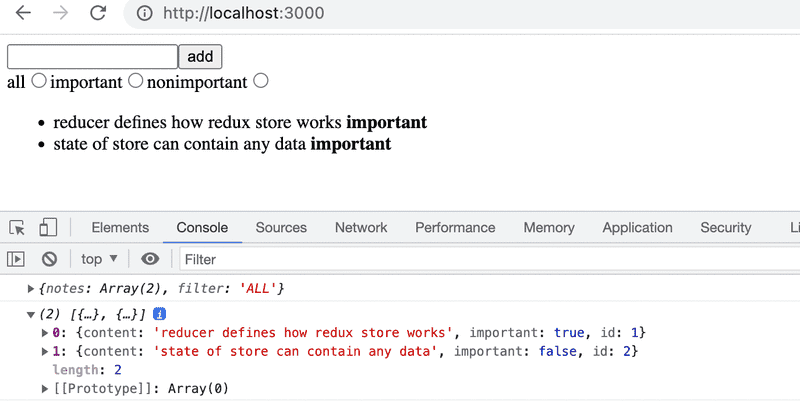
Redux DevTools
Redux DevTools is a Chrome addon that offers useful development tools for Redux. It can be used for example to inspect the Redux store's state and dispatch actions through the browser's console. When the store is created using Redux Toolkit's configureStore function, no additional configuration is needed for Redux DevTools to work.
Once the addon is installed, clicking the Redux tab in the browser's developer tools, the Redux DevTools should open:
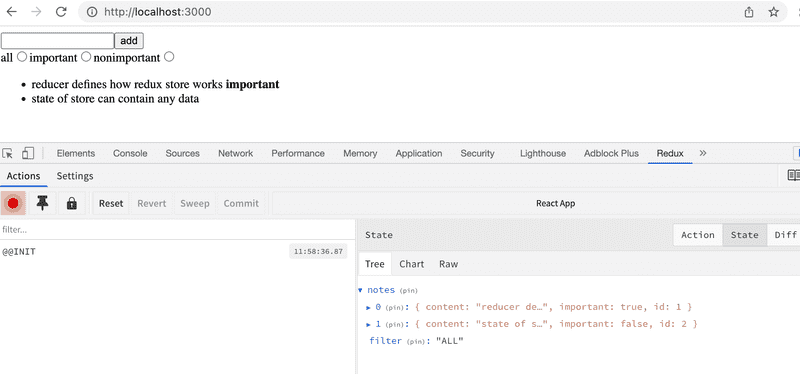
You can inspect how dispatching a certain action changes the state by clicking the action:
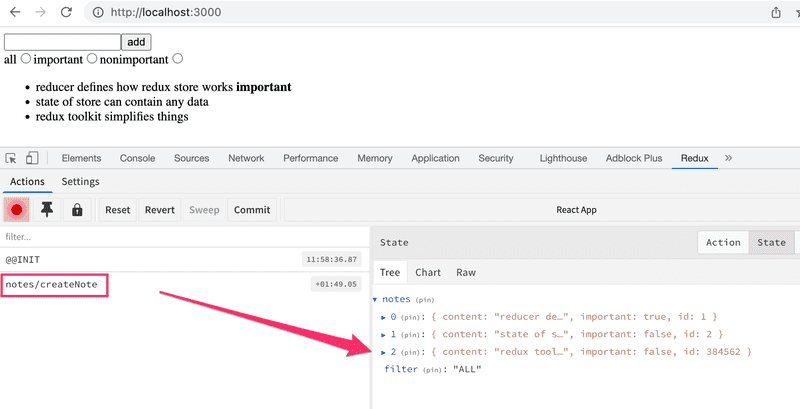
It is also possible to dispatch actions to the store using the development tools:
